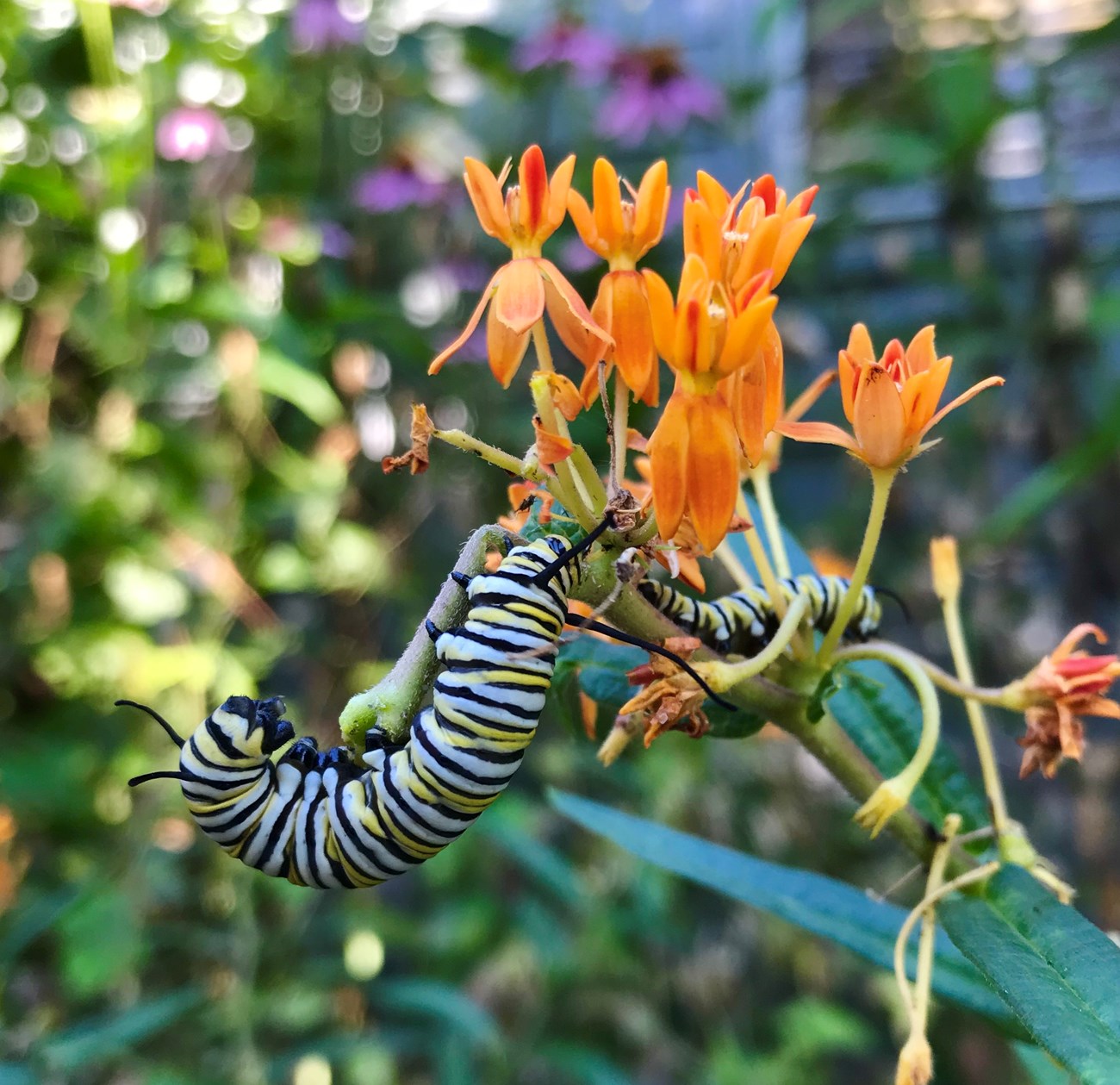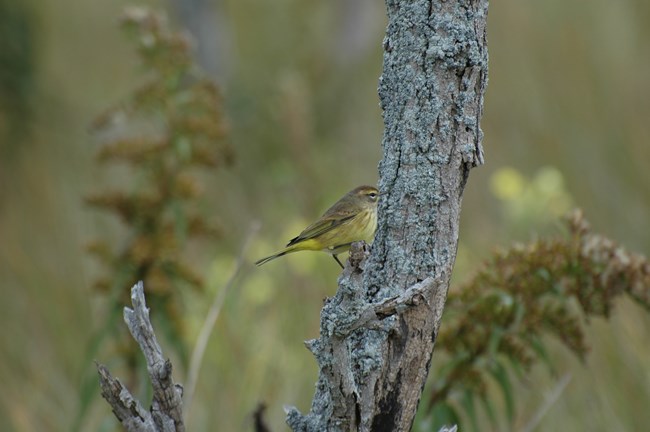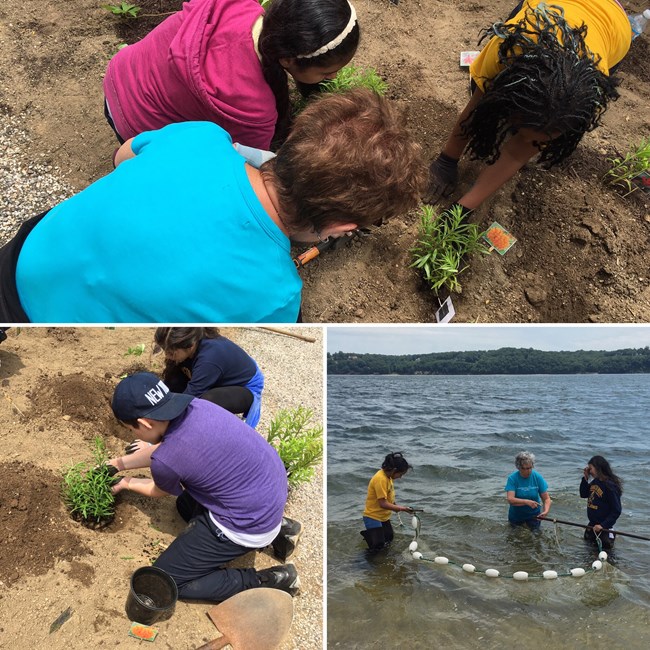
NPS/Tyler Kuliberda Sponsored by Huntington-Oyster Bay Audubon Society The Theodore Roosevelt Sanctuary and Audubon Center New York Audubon Society National Park Service 
NPS/Scott Gurney Background
Habitat loss and invasive plants are the leading cause of native biodiversity loss. Over the past century urbanization has taken intact, ecologically productive land and fragmented and transformed it into residential, industrial or commercial real estate or converted it to ball fields and other intensely used recreational areas. In that time the continental United States has lost a 150 million acres of habitat and farmland to managed urban and suburban landscapes. The modern obsession with highly manicured “perfect” lawns alone has created a green, monoculture carpet across the country that covers more than 40 million acres. In addition, nonnative invasive plant species have become dominant features in many of our remaining natural areas. Invasive plant species spread quickly and can displace native plants, prevent native plant growth, and create unhealthy monocultures. A healthy plant community has a variety of herbs, shrubs, and trees, which act as food sources, whereas an area that has been invaded by nonnatives becomes barren and sterile with little benefit to wildlife.
According to the United States Department of Agriculture, an invasive species is one "whose introduction causes or is likely to cause economic or environmental harm or harm to human health." These species have few, if any, natural enemies here and will swiftly crowd out and out-compete native plant species, altering ecosystems and causing a loss of biodiversity, thereby depriving wildlife of vital food sources and decreasing reproduction success.
Studies show that nearly a third of the nation’s 800 bird species are endangered, threatened or in significant decline. The reasons include massive casualties from window collisions, habitat loss, invasive species and climate change.
Native pollinators—bees, butterflies, moths, bats and birds—play a critical role in sustaining ecosystems and provide essential services to American agriculture (estimated at as much as $9 billion annually). Yet pollinators are in trouble. More than 50 native bees are in documented decline, with 9 critically imperiled. Another iconic North American pollinator—the monarch butterfly—is in severe decline, down from a billion monarchs 20 years ago to 35 million today. Research shows that native pollinators can be two to three times as effective at pollinating agricultural crops as non-native honeybees. Bees and other insect pollinators in decline for several reasons, including habitat loss, degradation, and fragmentation; non-native species and diseases; pollution, including pesticides; and climate change.

NPS/Scott Gurney Native plants are critical because they support native insects, most of which are specialists rather than generalists and will not feed on non-natives. Insects are a critical food source for a variety of birds and other animals, particularly those raising young. Baby birds depend on a steady diet of insects for survival. Native plants support 35% more caterpillar biomass than nonnatives do. A dearth of insects means a decline in bird species. One 6-year study in Ohio determined that Northern cardinals paid a steep price when nesting in areas thick with honeysuckle: these birds reared 20% less young than did cardinals nesting in native plants. In addition, according to these studies, birds that ate the berries from these plants were artificially bright, signifying to females that they were good choices for mates. Normally male cardinals with a deeper red color are more fit because they are feeding on nutrient rich berries that contain carotenoid pigments. Honeysuckle berries contain lots of carotenoid pigments but are nutrient poor. Coloration becomes meaningless as a sign of quality in a mate with the results being that females are mistakenly choosing less fit males as mates. This can lead to population declines as less sturdy genes are passed on from generation to generation.
Our native insect pollinators have also evolved with native plants. While some pollinators are generalists and forage on many different plants, others may have evolved to use a single plant species. The iconic monarch butterfly is one of the most recognizable species of wildlife in all of America. Each year, this butterfly undertakes one of the world’s most remarkable and fascinating migrations, traveling thousands of miles over many generations from Mexico, across the United States, to Canada. The monarch butterfly is severely threatened the loss of milkweed habitat needed to lay their eggs and for their caterpillars to eat, which is having a devastating impact on their populations and the migration phenomenon. Because of this, it is critical that habitat and host plants be provided to these charismatic butterflies.
As habitat decreases, native “habitat pocket” landscaping can become critical links needed to create contiguous habitat corridors for wildlife.

NPS/Scott Gurney
Perhaps the most important role birds play is how they can connect us, no matter where we are, to the natural world in the blink of an eye. Standing at the kitchen counter, a store front on a busy street, the top floor of a high rise building, or even sitting in an idling car at a stoplight, the appearance of a bird reminds us immediately that there is another, more beautiful place beyond the day we are experiencing. Birds bring nature to us, no matter where we are, no matter how harried or hurried our day. This priceless gift is why birds matter and why we should be doing all we can to protect them. As gardeners and stewards of our land, we have never been so empowered to help save biodiversity from extinction, and the need to do so has never been so great."

NPS/Scott Gurney

NPS/Clayton Hanson The National Park Service, Huntington Oyster Bay Audubon Society Chapter, Theodore Roosevelt Sanctuary and Audubon Center, and the New York Audubon Society are partnering to establish a native plant demonstration garden located in front of the Sagamore Hill NHS Visitor Center. The garden will be used to inform the public about native plants and their use on landscapes to improve native wildlife and plant diversity. A series of small signs will be installed to inform the passing park visitors about the project and its benefits. The addition of wooden rain barrels to collect rain water used to irrigate the native plants may be included on either end of the project area, replenished by rain water runoff from the Visitor Center building.
The project is being established in a previously heavily disturbed area as a public demonstration to educate and inform. In addition, temporary seasonal signs will be placed along the public path through the area known as the Upper Pasture on the property to identify native plants in their natural habitat. This project and the partnership it promotes are intended to demonstrate the use and benefit of native plants for landscape ecology and preservation. The mission of the National Park Service is focused on the preservation and protection of natural and cultural resources for the understanding and enjoyment of this and future generations. The opportunity to work with a community partner such as the Huntington/Oyster Bay chapter and the local Theodore Roosevelt Audubon Sanctuary of the National Audubon Society to promote and implement such an informative and ecologically beneficial project is a valuable opportunity. The new team can be twice as effective working together toward our common missions to promote natural resources awareness and education opportunities. The conservation awareness and stewardship partnership is a model that supports long term community engagement to address pressing local and global environmental issues.
|
Last updated: September 13, 2018
